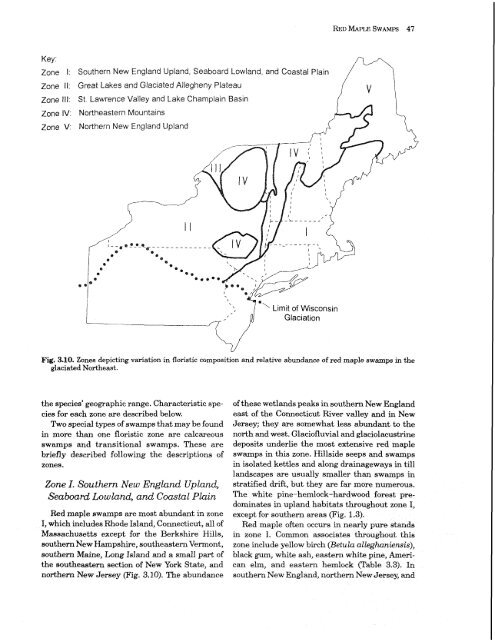Ecology of Red Maple Swamps in the Glaciated Northeast: A ...
Ecology of Red Maple Swamps in the Glaciated Northeast: A ...
Ecology of Red Maple Swamps in the Glaciated Northeast: A ...
You also want an ePaper? Increase the reach of your titles
YUMPU automatically turns print PDFs into web optimized ePapers that Google loves.
Key:<br />
Zone I:<br />
Zone II:<br />
Zone ill:<br />
Zone IV:<br />
Zone V:<br />
Sou<strong>the</strong>rn New England Upland, Seaboard Lowland, and Coastal Pla<strong>in</strong><br />
P?<br />
Great Lakes and <strong>Glaciated</strong> Allegheny Plateau<br />
i v l<br />
Fig. 3.10. Zones depict<strong>in</strong>g variation <strong>in</strong> floristic composition and relative abundance <strong>of</strong> red maple swamps <strong>in</strong> <strong>the</strong><br />
glaciated Nor<strong>the</strong>ast.<br />
<strong>the</strong> species' geographic range. Characteristic species<br />
for each zone are described below.<br />
Two special types <strong>of</strong> swamps that may be found<br />
<strong>in</strong> more than one floristic zone are calcareous<br />
swamps and transitional swamps. These are<br />
briefly described follow<strong>in</strong>g <strong>the</strong> descriptions <strong>of</strong><br />
zones.<br />
Zone I. Sou<strong>the</strong>rn New England Upland,<br />
Seabuard Lowland, and Coastal Pla<strong>in</strong><br />
<strong>Red</strong> maple swamps are most abundant <strong>in</strong> zone<br />
I, which <strong>in</strong>cludes Rhode Island, Connecticut, all <strong>of</strong><br />
Massachusetts except for <strong>the</strong> Berkshire Wills,<br />
sou<strong>the</strong>rn New Hampshire, sou<strong>the</strong>astern Vermont,<br />
sou<strong>the</strong>rn Ma<strong>in</strong>e, Long Island and a small part <strong>of</strong><br />
<strong>the</strong> sou<strong>the</strong>astern section <strong>of</strong> New York State, and<br />
nor<strong>the</strong>rn New Jersey (Fig. 3.10). The abundance<br />
<strong>of</strong> <strong>the</strong>se wetlands peaks <strong>in</strong> sou<strong>the</strong>rn New England<br />
east <strong>of</strong> <strong>the</strong> Connecticut River valley and <strong>in</strong> New<br />
Jersey; <strong>the</strong>y are somewhat less abundant to <strong>the</strong><br />
north and west. GIaci<strong>of</strong>luvial and glaciolacustr<strong>in</strong>e<br />
deposits underlie <strong>the</strong> most extensive red maple<br />
swamps <strong>in</strong> this zone. Hillside seeps and swamps<br />
<strong>in</strong> isolated kettles and along dra<strong>in</strong>ageways <strong>in</strong> till<br />
landscapes are usually smaller than swamps <strong>in</strong><br />
stratified drift, but <strong>the</strong>y are far more numerous.<br />
The white p<strong>in</strong>e-hemlock-hardwood forest predom<strong>in</strong>ates<br />
<strong>in</strong> upland habitats throughout zone 1,<br />
except for sou<strong>the</strong>rn areas Fig. 1.3).<br />
<strong>Red</strong> maple o&n occurs <strong>in</strong> nearly pure stands<br />
<strong>in</strong> zone I. Common associates throughout this<br />
zone <strong>in</strong>clude yellow birch (Betula alleghanknsis),<br />
black gum, white ash, eastern white p<strong>in</strong>e, American<br />
elm, and eastern hemlock (Table 3.3). In<br />
sou<strong>the</strong>rn New England, nor<strong>the</strong>rn New Jersey, and

















